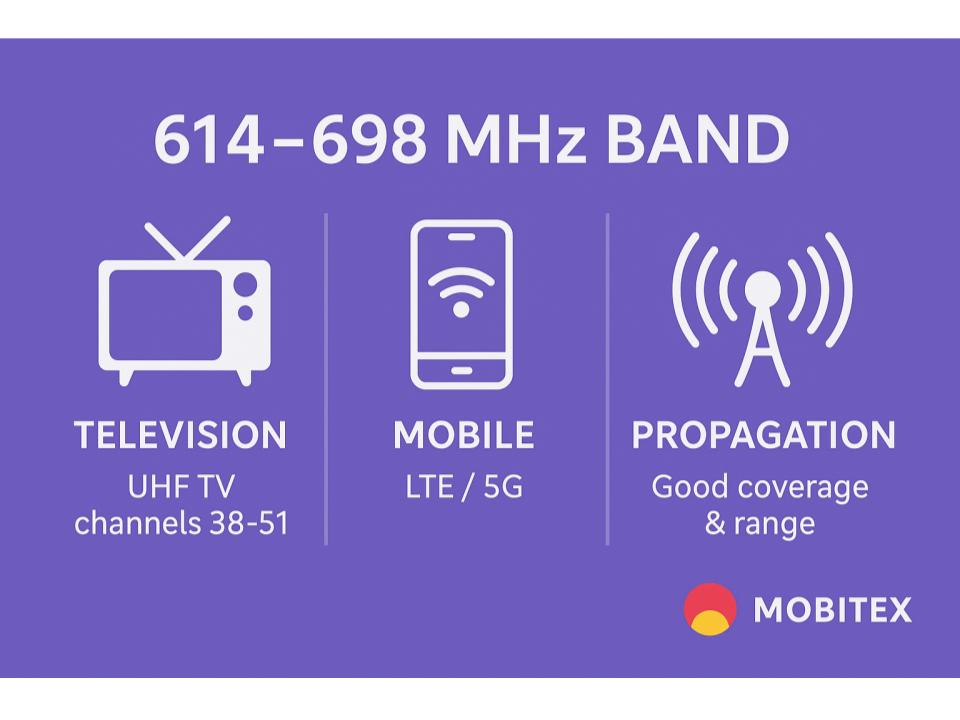📡 The 614–698 MHz band occupies the upper portion of the UHF spectrum, sitting just above the scientifically protected 608–614 MHz range and below the 700 MHz mobile bands. Historically used for television broadcasting, this segment of spectrum has been undergoing major reallocation in many countries to support mobile broadband, public safety, and wireless communication technologies.
🌍 Frequency Overview
- Frequency range: 614 MHz – 698 MHz
- Wavelength: Approximately 49 cm – 43 cm
- ITU Region: Used differently across regions, but typically within UHF TV channels 38–51
- Propagation: Excellent building penetration and long-range coverage, making it valuable for both broadcasting and mobile services
📺 Traditional Uses – Television Broadcasting
For decades, this band formed part of the UHF TV broadcast spectrum, supporting analog and later digital TV channels:
- Channel 38: 614–620 MHz
- Channel 51: 692–698 MHz
These frequencies were prized for their wide-area coverage and robust signal performance, particularly for rural and suburban television networks.
However, as digital TV became more efficient and broadband demand grew, regulators began “repacking” TV stations into lower channels to free up this spectrum for new technologies.
📶 Modern Uses and Reallocation
📱 Mobile Broadband (LTE / 5G)
Many countries have reallocated much of the 614–698 MHz band to mobile carriers as part of the 600 MHz spectrum auction.
- In North America, this range is now largely part of the 600 MHz mobile band, used for LTE Band 71 and 5G NR n71.
- Its superior propagation allows carriers to provide long-distance rural coverage and deep indoor penetration.
- These frequencies are key for improving connectivity in less populated areas and extending 5G availability.
🚨 Public Safety and Emergency Services
Before broadband deployment, portions of this band were designated for public safety communications. Some regions continue to reserve parts for:
- Fire and police digital trunked systems
- Emergency coordination networks
- Regional backhaul and interoperability channels
As broadband evolves, some of these systems are migrating to dedicated LTE/5G public safety networks.
🎤 Wireless Microphones and Event Production
Wireless microphones, intercoms, and similar devices historically operated in this band under auxiliary or secondary authorizations.
After the 600 MHz auction, these users were largely required to vacate the band or migrate to lower UHF channels (470–608 MHz) or unlicensed alternatives such as 1.9 GHz or 2.4 GHz.
🌐 White Space Devices (TVWS)
A small subset of 614–698 MHz may still support TV White Space devices – low-power broadband systems that operate opportunistically in unused channels.
These systems help provide rural broadband access by leveraging the excellent propagation characteristics of UHF frequencies.
⚙️ Regional Allocation Summary
| Region | Primary Uses | Notes |
|---|---|---|
| North America | Mobile broadband (LTE Band 71 / 5G n71), limited TV, white space devices | 614–698 MHz repurposed after FCC 600 MHz incentive auction |
| Europe | Broadcast television (upper UHF), transition to mobile in progress | Some nations freeing 700 MHz and gradually reassigning 600 MHz |
| Asia-Pacific | Mixed TV and mobile allocation | Many countries rebalancing UHF for 4G/5G expansion |
| Africa / Latin America | Primarily digital TV; early reallocation plans for mobile services | Dependent on digital migration timelines |
🧭 Technical Characteristics
| Property | Description |
|---|---|
| Frequency range | 614–698 MHz |
| Propagation | Strong indoor penetration, wide-area coverage |
| Typical bandwidth (per TV channel) | 6 MHz |
| Common channel uses | TV 38–51, LTE Band 71, 5G n71 |
| Power limits | Vary by region and license (broadcasters vs. mobile vs. white space) |
💡 Why This Band Matters
The 614–698 MHz range is a transition zone in spectrum policy:
- It marks the shift from traditional broadcast television to next-generation mobile and broadband communication.
- Its propagation efficiency makes it one of the most valuable ranges below 1 GHz.
- Future technologies – such as rural IoT, smart agriculture, and low-power sensor networks, will likely build on this same foundation.
🛰️ In Summary
The 614–698 MHz band has evolved from a cornerstone of television broadcasting into a critical asset for modern communication infrastructure.
- Formerly: UHF TV channels 38–51
- Now: A mix of mobile broadband, emergency communication, and limited secondary services
- Future: Expanding rural connectivity and 5G innovation

